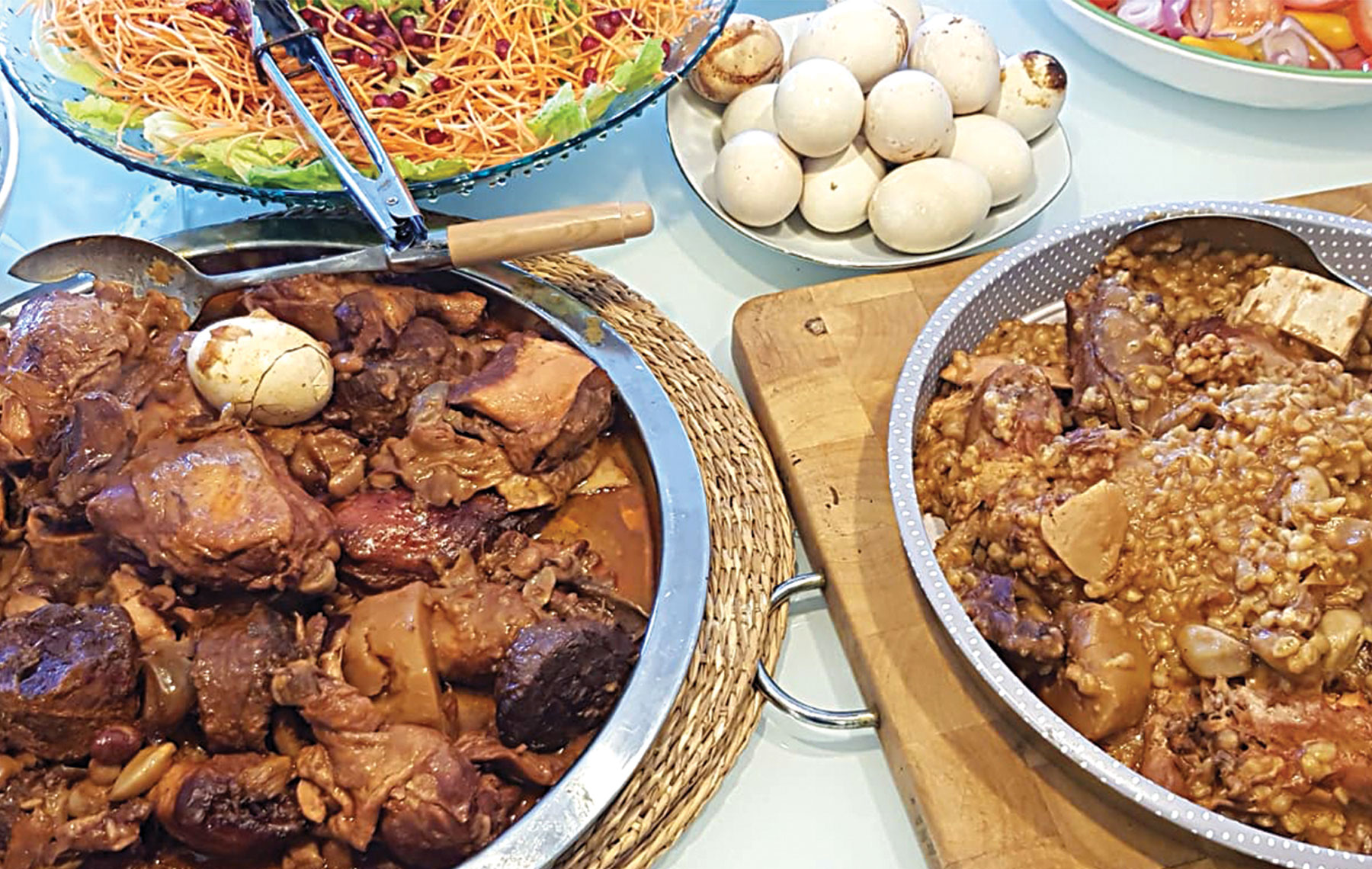
There are some dishes that require a few chefy techniques to come out well, although I maintain those are few and far between. Then there are classics, like chicken soup, that once you know the tricks, they require no more measuring or tinkering to be consistently pleasing.
Then there is a hamin or a cholent, depending on where in the world your people came from, which like all good peasant food requires very little in terms of technique, rather some tips passed down through the generations.
A cholent, a uniquely Jewish food, is a Shabbat dish that was born out of its observance. It is prepared on Friday afternoon before sundown and cooked overnight at a very low oven temperature, then eaten Saturday for lunch after returning from services. This provides a hot, hearty meal without violating the commandment against cooking on the Sabbath. In Israel, there are still whole communities in Jerusalem that cook their cholent communally, usually in a town baker’s wood-fired oven; a revival of dish’s popularity in Tel Aviv has many restaurants selling it made to order by the pot.
Food historians attribute the word cholent to the French chaud lent, meaning “to warm slowly.” Food journalist and cookbook author Joan Nathan theorizes the dish likely originated in ancient Israel and migrated to France and then to the rest of Europe. Apparently, when the Spanish Inquisition forced the Jews out of Spain and into Eastern Europe the dish’s ingredients changed from lamb and chickpeas to beef, beans, barley and potatoes.
For the Jews who escaped Spain and fled to northwestern Africa across the Strait of Gibraltar, the ingredients of the hamin evolved according to what was available locally, and called a dafina, which means “covered” in Arabic. The dish traditionally was buried in a pit and covered with hot ashes on the eve of Shabbat, with household residents picking up their cooked treasure on their way home from synagogue. Although the recipe for a Moroccan dafina varies from city to city and from family to family, every Jewish house was distinguished by its dafina, and legend has it that the noble rabbis could sense the peace and holiness of the house from the smell of the Shabbat stew. While the spices of an Eastern European cholent usually are restricted to salt, pepper and paprika, a Moroccan dafina usually includes sweet potatoes, honey, cinnamon, cumin and dates.
Sephardic Jews tend to include packages of rice and brown eggs called haminados in their hamin but Ashkenazi Jews tend to use root vegetables and kishke, a sausage made of shmaltz, flour and vegetables. The Jews of France adopted a version of this stew and called it schalet. Jewish food historian Gil Marks said all three versions — hamin, schalet and cholent — consisting of beans and meat, seasoned with onions and slow-cooked overnight, were the basis for the iconic southern French cassoulet, and that there is a good chance the medieval dish had its roots in Judaism.
Because Jews have been scattered all over the world for centuries, there are as many recipes for a hamin as there are cooks. In Israel, I once sampled an exquisite hamin prepared by an Argentine cook who slow cooked duck breasts stuffed with pasta and stewed with prunes. The long tradition of hamin, distinguished by region and imbued with the flavors of many cultures, is also one of extended family and even neighbors. After all, one cannot make a cholent for two; by definition, it is an experience of communal eating. And although you must plan ahead to make it, soaking the beans and grains overnight is hardly cause for concern. From there, it is a straightforward and meditative one-pot wonder that hardly involves the interference of the cook except for the very beginning of the process.
While I prefer to cook my cholent in the oven, I know there are many who use a countertop slow cooker, a tool that can be turned on and forgotten about until the next day. I also don’t, as many do, add ketchup, cola or honey to my cholent; rather I employ some techniques using caramelized sugar, onion skins and a tea bag to deepen the signature brown color of the dish.
Cholent enthusiasts are divided over whether to pre-sear the meat but I am adamant in searing it although it’s an extra step.
In addition, I also always include chicken thighs and homemade chicken stock in my cholent. The reasons for this are obvious: Shmaltz imbues the flavor of beans and everything it touches with a savory quality that cannot be replaced, and the gelatin produced by the chicken bones in the stock creates a “protein crust” and a viscosity that is otherwise impossible to achieve without it.
Even though I tend to identify with my Sephardic side, certainly when it comes to my food tastes, this is one case where I move more toward my Ashkenazic side. I prefer kishke over rice and white beans over chickpeas. I don’t use any Middle Eastern spices, opting for the more traditional paprika, salt and pepper only. The nod to my Sephardic side ends with the insistence on adding haminados in the pot. I tend to serve my cholent with a variety of fresh salads and pickles. I find the acidity in the dressing necessary to cut the richness of the stew.
As for leftovers, this is one stew that guests are happy to take home but if not, it makes a wonderful soup the next day, thinned with some extra broth and served with toasted bread. It’s almost like another dish entirely.
As we enter the darkness and chill of winter, it doesn’t matter what you call it — cholent or hamin, dafina or schalet — as it always has been, this is one dish that will perfume the houses of Jews on Shabbat until the end of time.
YAMIT’S CHOLENT
2 tablespoons oil or chicken fat
4 large kosher chicken thighs (skin on)
2 pounds fatty, kosher beef-brisket, flanken or short rib, chopped into 2-inch pieces
2 large yellow onions, cleaned and chopped (reserve skins)
5 cloves garlic, peeled and left whole
1 pound russet potatoes, peeled and quartered
1 pound sweet potatoes, peeled and quartered
2 large marrow bones, soaked in salted water until very white
1/2 pound dried white beans or cannellini beans, soaked overnight
1/2 cup pearl barley (or wheat berries or freekeh), soaked overnight
2 teaspoons salt
1 teaspoon black pepper
1 tablespoon sweet paprika
1 tablespoon sugar, caramelized in a pan until brown
1 quart (or to cover) strong chicken stock
1/2 pound kishke, plastic casing removed
6 large eggs, boiled for 3 minutes and drained
1 black tea bag
In a large, 10-quart, heavy-bottomed pot with a tightly fitting lid, brown the chicken thighs and beef in oil. Remove the meat, set aside and fry the onions until soft. Add the garlic and fry until the aroma rises.
Add half the potatoes and sweet potatoes to the pot, add the marrow bones and arrange the beef, chicken, drained beans and barley on top, and then the other half of the potatoes sprinkling each layer with salt, pepper and paprika as you go. Add the caramelized sugar.
Cover with stock. Steep teabag in a cup of boiling water or stock and add the liquid to the pot. Add onion skins. Bring pot to a boil. Remove any scum that rises. Arrange kishke on top and then the eggs. Make sure all items are submerged at least 3/4 of the way in liquid and then put the lid on and transfer to the lowest-temperature oven (200 degrees F.) overnight.
Check on it in the morning and add boiling water should the stew look dry. Cook for at least 14 hours and up to 18 hours before serving.
Serves 12.
Yamit Behar Wood, an Israeli-American food and travel writer, is the executive chef at
the U.S. Embassy in Kampala, Uganda, and founder of the New York Kitchen Catering Co.























 More news and opinions than at a Shabbat dinner, right in your inbox.
More news and opinions than at a Shabbat dinner, right in your inbox.